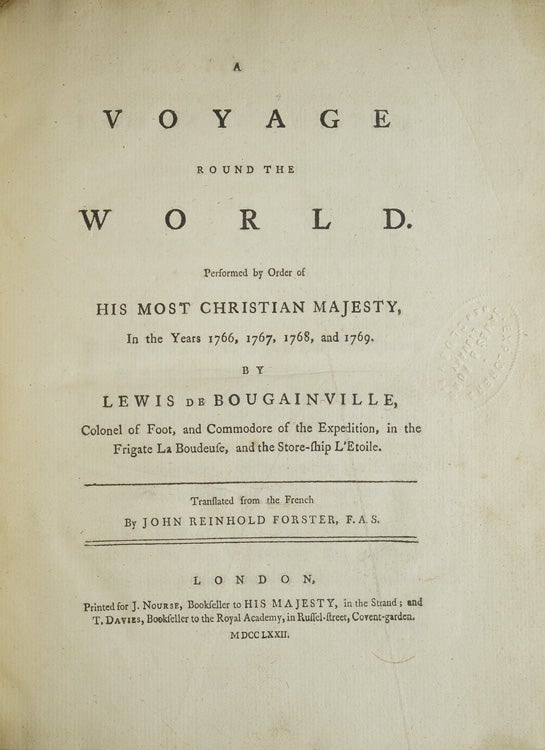
The First English Edition of the First French Circumnavigation
A Voyage round the World…In the years 1776, 1767, 1768, and 1769…Translated from the French by John Reinhold Forster F.A.S.
London: Printed for J. Nourse…and T. Davies…, 1772.
Price: $3,000.00
About the item
First English Edition. 12 engraved maps and charts on 5 folding plates (including the Straits of Magellan), one folding engraved plate with the 3 images of Polynesian pirogues and a canoe, with the Tahitian vocabulary. xxviii, 476pp. 1 vols. 4to. The First English Edition of the First French Circumnavigation. Nineteenth century half calf and marbled paper boards, rebacked retaining the original morocco lettering piece. Title and first map with the blindstamp of The Explorer's Club library, minor foxing throughout. Hill 165; Sabin 6869; Kroepelien 113; O’Reilly and Reitman 285; ESTC T82890.
Item #305955
Bougainville’s command was to first turn over the Falkland (Malvinas) Islands to the Spanish, allies of the French. He tells the story of the discovery and occupation of the Falklands, and devotes a chapter to their natural history. He was at Buenos Aires when the order came to expel the Jesuits of Paraguay, which he describes in detail. He then continued through the Straits of Magellan and across the Pacific to the East Indies and thence home in a three year voyage which was France’s first official circumnavigation of the word. Many Pacific Islands were visited (there is a lengthy description of Tahiti, including a 300 word vocabulary of words used on the island at the end of the book), and although Bougainville made few important discoveries, the effect of his voyage on the French was to stimulate their interest in the Pacific, and inspire the later voyages of Du Fresne and La Pérouse. Bougainville (after whom the tropical flower is named) later fought in the American Revolution and was made a count of the Empire by Napoleon.
First published in French in 1771, the English edition was translated by Forster.

